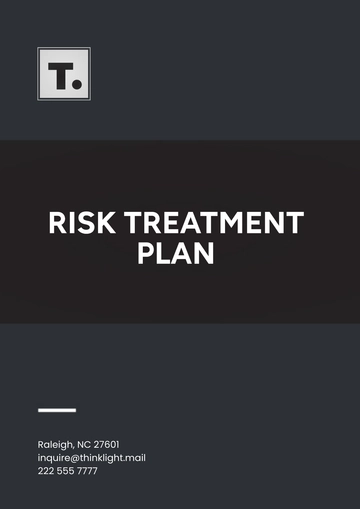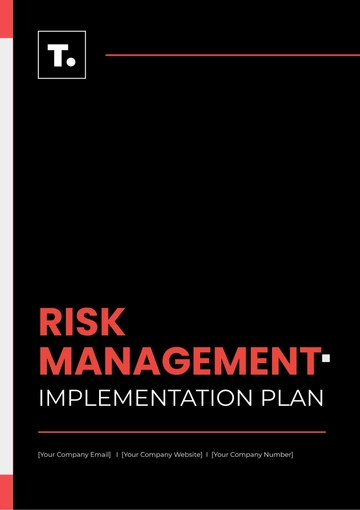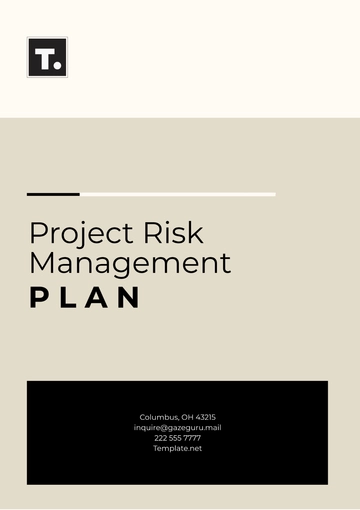Free Insurance Compliance Plan Outline

Date: [Date]
Prepared By: [Your Name]
I. Executive Summary
The purpose of this Insurance Compliance Plan is to ensure our organization adheres to all regulatory, legal, and ethical standards in the provision of insurance services. Our commitment to compliance not only protects our clients but also reinforces the integrity of our operations. The plan focuses on aligning our policies with industry regulations, managing risk, and maintaining a culture of compliance across the organization.
II. Introduction
This compliance plan is designed to guide the organization in meeting its obligations under various regulatory frameworks, including federal and state insurance laws, privacy regulations, and anti-money laundering standards. The plan applies to all insurance products and services offered across our operational territories and aims to prevent non-compliance and mitigate associated risks.
III. Compliance Framework
Compliance Governance Structure
The compliance framework is managed by the Chief Compliance Officer (CCO), who reports directly to the board of directors. The CCO oversees a team of legal and compliance professionals responsible for regulatory oversight and internal policy enforcement.
Regulatory Environment
Key regulations impacting our operations include the Insurance Information and Privacy Protection Act (IIPPA), Anti-Money Laundering (AML) Regulations, and Health Insurance Portability and Accountability Act (HIPAA). Additionally, we comply with state-specific insurance laws and industry best practices.
Internal Policies and Procedures
Our internal policies include comprehensive data protection guidelines, clear anti-fraud protocols, and adherence to sales and marketing standards that align with legal requirements.
IV. Risk Assessment and Management
Risk Identification
Key risks include regulatory fines for non-compliance, fraud, cybersecurity breaches, and reputational damage. We also face operational risks such as inadequate staff training or insufficient monitoring of client data.
Risk Evaluation
Risks are evaluated based on likelihood and potential impact. For example, the risk of a regulatory fine due to failure to comply with state laws is high and could result in significant financial penalties.
Risk Mitigation Strategies
We mitigate risks by regularly updating our training programs, implementing advanced compliance software to monitor transactions, and establishing clear protocols for reporting discrepancies or suspicious activities.
V. Compliance Monitoring and Auditing
Monitoring Process
We employ automated systems that track regulatory compliance across all departments, flagging any activities that deviate from legal requirements. Monthly reports are generated to monitor ongoing compliance.
Auditing
Internal audits are conducted quarterly, with a detailed review of financial transactions, claims processing, and customer data handling. Third-party auditors are also engaged annually to assess the adequacy of our compliance systems.
Audit Findings
Past audits have highlighted areas such as inconsistent documentation in client onboarding processes, which have since been addressed by updating policies and implementing stricter documentation protocols.
VI. Employee Training and Awareness
Training Programs
All employees undergo mandatory training on industry regulations, company compliance policies, and ethical guidelines. Training is conducted biannually, with a certification program for key compliance personnel.
Awareness Campaigns
Monthly internal newsletters and annual seminars are used to keep staff informed about regulatory changes, new risks, and the company’s stance on ethical behavior and compliance.
VII. Reporting and Documentation
Reporting Mechanisms
Employees are encouraged to report any compliance violations through a confidential whistleblower system. All reports are reviewed promptly by the compliance team to ensure appropriate action is taken.
Documentation and Record Keeping
We maintain comprehensive records of client interactions, claims, and policy transactions for a period of seven years to comply with federal and state record retention requirements. All documentation is stored securely in compliance with privacy regulations.
VIII. Enforcement and Disciplinary Actions
Enforcement Measures
Employees found in violation of compliance protocols are subject to corrective actions, including retraining, suspension, or termination based on the severity of the breach.
Disciplinary Procedures
Our disciplinary procedures are clearly defined in the employee handbook. Violations such as fraudulent claims or data breaches are immediately escalated to management for swift action.
IX. Continuous Improvement and Updates
Feedback Mechanisms
Feedback from employees, customers, and stakeholders is collected through surveys and direct communication. This information is used to identify areas for improvement and ensure that our compliance plan remains relevant and effective.
Regular Review and Updates
The compliance plan is reviewed and updated annually to incorporate changes in laws and regulations. The CCO ensures that the updates are communicated to all relevant departments.
Adapting to Industry Changes
We actively participate in industry conferences and collaborate with regulatory bodies to stay ahead of trends and changes in the insurance landscape, ensuring that we continuously adapt our policies.
X. Conclusion
This Insurance Compliance Plan reflects our unwavering commitment to upholding the highest standards of legal, ethical, and regulatory adherence. Through diligent risk management, continuous employee education, and robust monitoring, we aim to safeguard our business and clients against compliance risks while fostering a culture of transparency and accountability.
- 100% Customizable, free editor
- Access 1 Million+ Templates, photo’s & graphics
- Download or share as a template
- Click and replace photos, graphics, text, backgrounds
- Resize, crop, AI write & more
- Access advanced editor
The Insurance Compliance Plan Outline Template, offered by Template.net, is a customizable, downloadable, and printable tool designed to help businesses meet insurance regulations. This template is fully editable in our AI Editor Tool, allowing you to tailor it to your specific needs. Streamline your compliance process with ease and ensure your business stays aligned with industry standards. Ideal for professionals looking for a reliable and efficient solution.
You may also like
- Finance Plan
- Construction Plan
- Sales Plan
- Development Plan
- Career Plan
- Budget Plan
- HR Plan
- Education Plan
- Transition Plan
- Work Plan
- Training Plan
- Communication Plan
- Operation Plan
- Health And Safety Plan
- Strategy Plan
- Professional Development Plan
- Advertising Plan
- Risk Management Plan
- Restaurant Plan
- School Plan
- Nursing Home Patient Care Plan
- Nursing Care Plan
- Plan Event
- Startup Plan
- Social Media Plan
- Staffing Plan
- Annual Plan
- Content Plan
- Payment Plan
- Implementation Plan
- Hotel Plan
- Workout Plan
- Accounting Plan
- Campaign Plan
- Essay Plan
- 30 60 90 Day Plan
- Research Plan
- Recruitment Plan
- 90 Day Plan
- Quarterly Plan
- Emergency Plan
- 5 Year Plan
- Gym Plan
- Personal Plan
- IT and Software Plan
- Treatment Plan
- Real Estate Plan
- Law Firm Plan
- Healthcare Plan
- Improvement Plan
- Media Plan
- 5 Year Business Plan
- Learning Plan
- Marketing Campaign Plan
- Travel Agency Plan
- Cleaning Services Plan
- Interior Design Plan
- Performance Plan
- PR Plan
- Birth Plan
- Life Plan
- SEO Plan
- Disaster Recovery Plan
- Continuity Plan
- Launch Plan
- Legal Plan
- Behavior Plan
- Performance Improvement Plan
- Salon Plan
- Security Plan
- Security Management Plan
- Employee Development Plan
- Quality Plan
- Service Improvement Plan
- Growth Plan
- Incident Response Plan
- Basketball Plan
- Emergency Action Plan
- Product Launch Plan
- Spa Plan
- Employee Training Plan
- Data Analysis Plan
- Employee Action Plan
- Territory Plan
- Audit Plan
- Classroom Plan
- Activity Plan
- Parenting Plan
- Care Plan
- Project Execution Plan
- Exercise Plan
- Internship Plan
- Software Development Plan
- Continuous Improvement Plan
- Leave Plan
- 90 Day Sales Plan
- Advertising Agency Plan
- Employee Transition Plan
- Smart Action Plan
- Workplace Safety Plan
- Behavior Change Plan
- Contingency Plan
- Continuity of Operations Plan
- Health Plan
- Quality Control Plan
- Self Plan
- Sports Development Plan
- Change Management Plan
- Ecommerce Plan
- Personal Financial Plan
- Process Improvement Plan
- 30-60-90 Day Sales Plan
- Crisis Management Plan
- Engagement Plan
- Execution Plan
- Pandemic Plan
- Quality Assurance Plan
- Service Continuity Plan
- Agile Project Plan
- Fundraising Plan
- Job Transition Plan
- Asset Maintenance Plan
- Maintenance Plan
- Software Test Plan
- Staff Training and Development Plan
- 3 Year Plan
- Brand Activation Plan
- Release Plan
- Resource Plan
- Risk Mitigation Plan
- Teacher Plan
- 30 60 90 Day Plan for New Manager
- Food Safety Plan
- Food Truck Plan
- Hiring Plan
- Quality Management Plan
- Wellness Plan
- Behavior Intervention Plan
- Bonus Plan
- Investment Plan
- Maternity Leave Plan
- Pandemic Response Plan
- Succession Planning
- Coaching Plan
- Configuration Management Plan
- Remote Work Plan
- Self Care Plan
- Teaching Plan
- 100-Day Plan
- HACCP Plan
- Student Plan
- Sustainability Plan
- 30 60 90 Day Plan for Interview
- Access Plan
- Site Specific Safety Plan





























